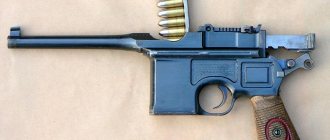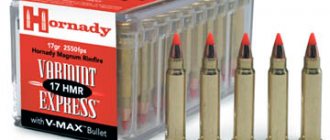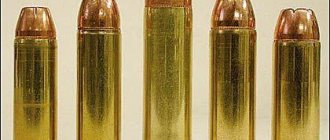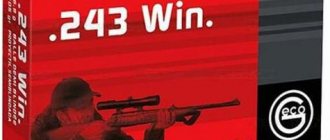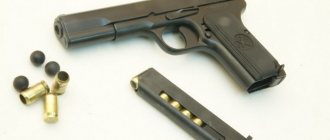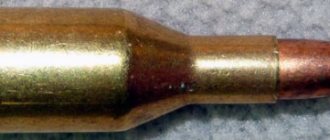| .222 Remington | |||
| Type | Rifle | ||
| Place of origin | United States | ||
| Service history | |||
| In service | 1950 | ||
| Production history | |||
| Manufacturer | Remington | ||
| Characteristics | |||
| Type of shell | Rimless, bottleneck | ||
| Bullet diameter | 0.224 in (5.7 mm) | ||
| Neck diameter | 0.253 in (6.4 mm) | ||
| Shoulder diameter | 0.357 in (9.1 mm) | ||
| Base diameter | 0.376 in (9.6 mm) | ||
| Rim diameter | 0.378 in (9.6 mm) | ||
| Rim thickness | 0.045 in (1.1 mm) | ||
| Case length | 1,700 in (43.2 mm) | ||
| Full Length | 2.130 in (54.1 mm) | ||
| Case capacity | 26.9 g H 2 O (1.74 cm 3) | ||
| Narezov twist | 1" 14" (360 mm) | ||
| Primer type | Small rifle | ||
| Maximum pressure | 50,000 psi (340 MPa) | ||
| Ballistic characteristics | |||
| 1.141 ft⋅lbf (1.547 J) | |||
| 50 gr (3 g) SP | 3,168 ft/s (966 m/s) | 1.115 ft⋅lbf (1.512 J) | |
| 55 gr (4 g) SP | 3,095 ft/s (943 m/s) | 1170 ft⋅lbf (1590 J) | |
| 60 g (4 g) VMax | 2,937 ft/s (895 m/s) | 1150 ft⋅lbf (1560 J) | |
.222 Remington CIP cartridge maximum dimensions.
All dimensions are in millimeters (mm) plus imperial units (inches).
0.222 Remington
or
5.7×43mm
(MCC), also known as
triple deuce
,
triple two
, and
treble two
, is a Centerfire rifle cartridge.
Introduced in 1950, it was the first commercial rimless .22 (5.56 mm) cartridge made in the United States. So it was a completely new design, without the parent body. [ citation needed
]. The 222 Remington was a popular target cartridge from its introduction until the mid-1970s and still has a reputation for accuracy. It remains a popular varmint or "varmint" cartridge at short to medium ranges with a preferred bullet weight of 40–55 grains and a muzzle velocity of 3,000 to 3,500 ft/s (915–1,067 m/s).
Introduction [edit]
The .222 Remington was introduced in the Remington Model 722 bolt-action rifle. [2] The cartridge's accuracy and flat trajectory led to its use in varmint and benchrest rifles. The faster .220 Swift and .22-250 Remington provided greater range than the .222 Remington. These larger cartridges have approximately 50% more power than the .222, but also have greater muzzle blast and barrel erosion. [1]
The .222 Remington is popular in Europe, where it is known as 5.7×43mm. Sako was one of the first European manufacturers to introduce Remington 222 rifles and cartridges, and German and Austrian hunters quickly adapted them to hunt deer-sized game.
Cartridge .222 Remington / 5.7×43
| .222 Remington |
The .222 Remington cartridge of 5.7x43 mm caliber is designated: .222 Rem / .222 Remington Rimless / .222 Remington / 5.7x43 Remington / 5.7x43 Sako / SAA 0580 / XCR 06 043 BGC 030. .222
Remington
cartridge more often referred to simply as .222 Rem. In Europe it is sometimes referred to as 5.7x43 or 5.6x43.
The .222 Remington cartridge was developed in 1950 as the original ultra-high-speed cartridge, which has no analogues among existing calibers, and is a high-velocity cartridge.
The release of the .222 Remington was timed to coincide with the start of mass production of the Remington M722 bolt-action repeating rifle.
The .222 caliber was an invention of Remington and was not based on any existing caliber and became the ancestor of a new, medium-power group of such ammunition.
.222 Rem. occupied an empty niche - before it, only small-caliber centerfire cartridges of low and high power existed. At the same time, we were talking about a completely new development, which was supposed to fill the niche between the long-outdated .218 Bee and .220 Swift cartridges. In this class there was also the .219 Zipper cartridge, which, however, due to the case with a protruding rim, was not very suitable for bolt-action rifles.
The .222 Remington cartridge almost instantly gained wide popularity throughout the world and can rightfully be called a legendary cartridge. At that time, it did not become widespread only in the countries of the socialist community.
Distinguished by excellent accuracy and low recoil, the cartridge was a new, completely original development.
The small caliber of the bullet, combined with its high muzzle velocity, made it possible to increase the effective firing range compared to the .22 Hornet cartridge.
The .222 Remington is one of the most popular 5.6 mm rifle cartridges around the world. European hunters prefer it as a cartridge for roe deer hunting and for training shooting; athletes value it for its high accuracy.
From the very beginning, the .222 Remington was a success among athletes. In his homeland, the USA, he quickly became a favorite among “benchresters” (shooting from a weapon mounted in a machine). In 1973, McMillan set a fantastic world record for shooting with a lightweight Var Mint rifle at 100 yards. He received a dispersion diameter of five shots of 0.229 mm. A serious competitor to this “baby” on the benchresting scene appeared only in the late 1970s in the form of the 6 mm PPC cartridge (Pindell-Palmisano Cartridge). However, today's leading shooters use the .222 Remington cartridge, especially at 100 m.
The .222 Remington cartridge is widely used for hunting large birds (grouse) and small animals (marmot, hare, fox) at a distance of up to 250 meters. When shooting from a confident distance, an accurate hit at the slaughter point allows you to catch game the size of a roe deer. However, in this case, the nature of the terrain is of great importance, since even a small natural obstacle, such as a tuft of grass or a thin twig, that finds itself in the path of a light bullet can significantly change the trajectory of its flight.
There is another reason for the enduring popularity of this cartridge. In some countries (France, Italy, etc.) there are certain bureaucratic difficulties in obtaining a license for weapons that can use military-grade live ammunition of the same caliber. To facilitate the sale of their weapons in such countries, many companies produce self-loading rifles chambered for .222 Rem, created on the basis of army samples of .223 Rem caliber. So, for example, in France they sell a commercial self-loading version of the Ml 6 rifle - Colt AR-15 chambered for .222 Rem, while in other countries - for the usual .223 Rem, etc.
Soon after the creation of the .222 Remington cartridge, various models of .222 Remington caliber rifles appeared on the arms market, manufactured by Savage, Mauser, Sako, Ceska Zbrojovka, etc. This, in turn, caused an increased need for new Remington cartridges, which were produced by many American and European ammunition manufacturers.
The .222 Remington cartridge is produced by many European and American companies with full-jacket and half-jacket bullets with a diameter of 5.7 mm, usually weighing 3.24-4.0 g, sometimes 2.6 g. Most gun manufacturers make barrels of this caliber with a pitch of 14 inches , while the optimal bullet weight is 3.56 g.
Ammunition manufacturers offer a wide selection of factory-made ammunition. Still, the .222 Remington is a typical home load cartridge. This is the basis of its legendary accuracy: precision equipment is rewarded with small dispersion diameters. In addition to the extremely favorable ratio of case geometry, mass and bullet diameter for athletes, the low recoil of the .222 Remington cartridge is added. Taking into account the large mass of varmint rifles, the recoil when firing this cartridge is almost unnoticeable.
Cases for the .222 Remington cartridge are made by all well-known manufacturers.
Many companies recommend using magnum-type primers. The best choices are Remington 71/2 and Federal 205 primers. For high-performance shooters, manufacturers have developed match primers that feature tight manufacturing tolerances. Among them are the following capsules: CCI BR4 and Federal 205 M.
But the most significant difference between hunting and sporting cartridges is the choice of bullets. In hunting, along with the necessary accuracy, the action of the bullet on the target plays a decisive role. And here for the .222 Remington cartridge, due to the widespread diameter of the bullet used in it (5.70 mm), there is a huge selection of bullets from all well-known manufacturers. But for a novice shooter, it is recommended to first focus on available factory-made cartridges. Hardly any other bullet diameter provides such a large selection of match bullets as the 5.70 mm. In their shape and design, they are focused exclusively on achieving maximum accuracy of fire.
There are three groups of match bullets. These are, first of all, classic full-jacket bullets, which, as a rule, have a lead core open at the bottom. The most common bullets are the hole-in-the-tip bullets, in which the lead core is inserted into the jacket from the front and then the head is formed. This inevitably creates a small hole at the top of the bullet. This design is especially common with Sierra's Matchking bullets and similar bullets from Nosier, Hornady and Speer. Also, as an alternative, bullets with a plastic tip appeared, which were originally designed for hunting. Nosier's Ballistic-Tip bullets, like Hornady's V-Max bullets, have proven to be ideal for sport shooting due to their optimal shape and workmanship. The leading position is occupied by bullets with a conical shank. This form is also preferable when mounting a bullet into a bullet casing.
When choosing a bullet, you need to think about its mass, which must certainly be consistent with the pitch of the rifling. The .222 Remington uses 356mm pitch as standard. This means that bullets weighing between 2.6 g and 3.6 g will be optimally stabilized along the trajectory. Heavier bullets require a smaller rifling pitch, which is not desirable when shooting the .222 Remington cartridge. The volume of the case perfectly corresponds to the specified bullet weights; for heavier bullets it is suitable with a number of limitations. Therefore, bullets weighing 3.4 g are most suitable for match shooting.
Fast-burning rifle powder is used as a propellant. Vihtavuori 120, 130, 133, 135, Norma 200 and 201, Rottweil R 901 and R 902 gunpowders have proven themselves especially well. Hodgdon produces a range of gunpowders that can be used to equip this cartridge, for example H 4198, H 322, BL-C (2), N 335, N 4895, Benchmark and Varget. Alliant's Reloder 7 powder works particularly well, and other manufacturers offer many options.
After point-and-shoot shooting became widespread, the popularity of the .222 Remington waned as many hunters chose to upgrade to the more powerful .223 Remington cartridge.
Externally, the .222 Rem cartridge can be distinguished from the .223 Rem cartridge by only one feature: the .222 Rem cartridge has a slightly longer neck and a lower “ceiling” of the powder gas pressure level (Pmax = 320 MPa) than the .223 Rem cartridge (Pmax = 370 MPa).
.222 Remington
The technical characteristics of the .222 Remington cartridge are as follows: small-diameter capsule of the Small Rifle type, maximum bullet diameter 5.70 mm, maximum case and cartridge lengths, respectively, 43.18 mm (trimming to 42.93 mm) and 54.10 mm, the maximum pressure of powder gases according to the CIP standard, measured by the piezoelectric method, is 320 MPa. The capacity of the sleeve is 1.70 g of water. Powder charge - 1.13-1.52 g (up to 1.6 g). Muzzle velocity and energy are respectively 957-1000 m/s (up to 1060 m/s) and 1465-1738 J (150-177 kgcm). At a distance of 100 m, the speed and energy are respectively 770 m/s and 960 J. At recommended shooting distances of 169-181 m, the bullet deviates from the aiming line no more: at a distance of 50 m - 1.2 cm, 100 m - 4.0 cm , 150 m - 3.0 cm, 200 m - 5.2 cm, 300 m - 41.6 cm.
Legacy[edit]
Size comparisons between .222 (left), .223 (center), and .222 Magnum (right)
The .222 Remington was eventually overtaken by the 6mm PPC in benchrest competition.
When the US military was looking for a new small-bore rifle cartridge, Remington started with the .222 Remington and expanded it to increase the powder capacity by about 20% in 1958 to make the .222 Remington Magnum. The large powder capacity put the velocity between the standard .222 Remington and the .22-250. The cartridge was not accepted by the military, but was put into mass production. [3] In 1963, the .222 Remington Special, also based on the .222 extended case, was adopted with the new M16 rifle as the .223 Remington/5.56mm NATO. The NATO cartridge had a capacity only 5% less than the Magnum . Given their similar performance to other cartridges and military acceptance, both the .222 Remington and .222 Magnum quickly became obsolete and were replaced by the .223 Remington.
Although the .222 Remington is rarely seen in current production in America, cartridges based on it are among the most popular in the world. In addition to the .222 Magnum and .223 Remington, the .222 also served as the parent case for the .221 Fireball, the fastest handgun cartridge produced.
The .222 Remington is still quite popular in Europe, where Sako, Tikka, Steyr and Sauer chambered rifles are produced in this caliber. Firearms typically chambered in .223 Remington/5.56×45mm NATO caliber are often chambered in .222 Remington for sale in countries where regulations restrict or prohibit civilian ownership of "military calibers". Examples of countries with such legislation include Spain and (formerly) France.

